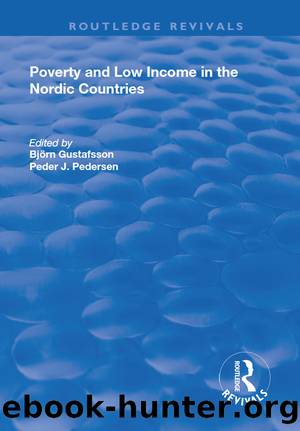Poverty and Low Income in the Nordic Countries by Björn Gustafsson Peder J. Pedersen

Author:Björn Gustafsson, Peder J. Pedersen [Björn Gustafsson, Peder J. Pedersen]
Language: eng
Format: epub
Tags: Social Science, Sociology, General
ISBN: 9781351787956
Google: cFoPEAAAQBAJ
Barnesnoble:
Publisher: Routledge
Published: 2018-05-08T02:46:17+00:00
In addition one would ideally want to have better representatives from the group of the unemployed as well as from those that are not active on the labour market. These figures are nonetheless important as indicators about what has been happening to the distribution of earnings on the labour market during the period. Changes in the overall distribution of incomes are likely to have affected the probability that people in the lower rungs of the distribution might drop below the poverty level. On the whole, one would expect that an increase in inequality might increase the size of the poverty population, at least when measured in relative terms.
The Gini indices show a creeping trend towards increased inequality in the distribution of employment earnings. The figures are highest for all taxpayers 16 years of age and above, slightly lower when the age bracket is narrowed to 25â65 and the inequality is further reduced when one only considers couples or only married males between 25 and 65 years of age.
The next figure (Figure 4.3) shows some of the effects of the large fluctuations of the gross national income in Iceland, as well as the developments in wages and salaries during recent years.
Figure 4.3 Purchasing power of LO (ASÃ) wages, minimum wages and monthly earnings of LO members, between 1980 and 1994
In 1983â4 there was a major recession in the fishing sector which was met with a drastic reduction of real pay levels. Unemployment increased slightly at the same time. This recession was, however, a short term one, as usual, and the following upswing was quite powerful. The year 1987 was the peak year both in terms of GNP and real pay levels. The period from 1988 to 1994 can perhaps best be described as a period of stagnation which nonetheless shows some significant signs of revival from 1994. On the whole, pay reductions tend to be slightly more drastic than reductions of earnings during periods of recession, and this is quite clear from the figure above. What is particularly interesting from the figure is the development of the minimum wage, which has lagged slightly behind in the last years. The purchasing power of the minimum wage has, however, been better maintained than appears from the graph due to a few supplementary payments to low wage earners, which have resulted from collective bargaining in the labour market since 1988. When those payments are taken into account, the drop in the real minimum wage rate in the last two years disappears and a more stable pattern emerges. On the whole then, the development of minimum wages is not likely to have caused any significant equalising effects in the income hierarchy, as indeed was indicated in Figures 4.1 and 4.2.
Figure 4.4 shows the developments of some major social security benefits from 1980 to 1994. This is an important indicator of how the section of the population which stands outside the labour market and has to rely on welfare benefits for subsistence has been faring during recent years.
Download
This site does not store any files on its server. We only index and link to content provided by other sites. Please contact the content providers to delete copyright contents if any and email us, we'll remove relevant links or contents immediately.
Zero to IPO: Over $1 Trillion of Actionable Advice from the World's Most Successful Entrepreneurs by Frederic Kerrest(4281)
Machine Learning at Scale with H2O by Gregory Keys | David Whiting(4169)
Never by Ken Follett(3787)
Harry Potter and the Goblet Of Fire by J.K. Rowling(3772)
Ogilvy on Advertising by David Ogilvy(3503)
Shadow of Night by Deborah Harkness(3297)
The Man Who Died Twice by Richard Osman(2995)
Book of Life by Deborah Harkness(2863)
The Tipping Point by Malcolm Gladwell(2824)
Will by Will Smith(2789)
0041152001443424520 .pdf by Unknown(2783)
My Brilliant Friend by Elena Ferrante(2771)
How Proust Can Change Your Life by Alain De Botton(2742)
Purple Hibiscus by Chimamanda Ngozi Adichie(2648)
How to Pay Zero Taxes, 2018 by Jeff A. Schnepper(2591)
Hooked: A Dark, Contemporary Romance (Never After Series) by Emily McIntire(2496)
Rationality by Steven Pinker(2290)
Borders by unknow(2226)
Can't Hurt Me: Master Your Mind and Defy the Odds - Clean Edition by David Goggins(2225)
